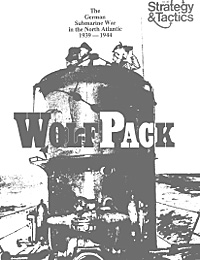
Introduction
Wolfpack is a historical simulation of the decisive North Atlantic conflict of World War II in which German U-Boat packs preyed on Allied merchant convoys and almost succeeded in severing Britain’s vital sea communication with North America, democracy’s arsenal. As the convoy system functioned defensively against offensive U-Boats operations, Wolfpack is strictly a solitaire game in which a single player controls both of the opposing forces.
Credits
Designed by James F. Dunnigan Published by SPI (S&T47 1974)
Components
1 22"x34" paper map
Counter sheet of 240 die-cut counters
12 pages landscape rule folder
Counter Manifest
Allies (Black on green)
5 Eastbound Slow Convoy (SC)
5 Eastbound Fast Convoy (HX)
5 Westbound Slow Convoy (ONS)
5 Westbound Fast Convoy (ON)
4 Eastbound Escort Group (EG)
4 Westbound Escort Group (EG)
3 Eastbound Support Group (SG)
2 Westbound Support Group (SG)
1 Eastbound Escort Carrier (CVE)
2 Westbound Escort Carrier (CVE)
12 Dummy Escort
3 Seven Hex Range Air Unit
6 10-Hex Range Air Unit
10 12-Hex Range Air Unit
3-16 Hex Range Air Unit
2 20-Hex Range Air Unit
Player’s Value
Wolfpack is a solo game where the player is responsible, as German, for one month of convoy hunting with all the U-Boats present in the North Atlantic. The game play is really straightforward, following a rigid sequence of play with mechanical actions for the Allied side. The map displays the North Atlantic convoy zones between Ireland, Greenland, Newfoundland and the Azores Islands.
For each of the four scenarios, 20 convoys will try to cross the ocean, 10 from each side. Five are already on the sea and 15 will enter, one per turn. Of these 20 convoys, 12 are dummy, just here to abuse the Germans. All the convoys are protected by an escort, with strength and type randomly selected during the set-up.
After the new convoy entry phase of the turn, the weather is processed by moving the storms across the map, which scatter the convoys in the storms’ path, and the possible arrival of new storms and fog.
The weather in this part of the ocean seems really horrible for the convoys, but can be useful for the U-Boats as they can catch scattered convoy or can hide away from air searches. Following is the air phase where the land-based aircraft, according to their range, will try to protect convoys and will search for U-Boat concentrations.
As sighted submarines can be sunk, it is a bad idea for the Germans to come too close to the bases. The next phase is used to move the convoys in an erratic manner roughly east or west across the Atlantic. The U-Boats directly in the convoy path can try to sight the ships, but can also be found and sunk themselves.
Finally, the U-Boats can be grouped or split into different pack sizes and moved. After all movement, sighted convoys can be attacked to generate victory points in the way of tonnage sunk.
There are four scenarios: February, March, April and May 1943, each of which lasts 15 turns. The number of U-Boats, Air Force size and range, strength and composition of the escorts will be different. The February scenario can be easily won, but the May scenario, with CVE and enhanced Air Force, is a very tough challenge. There are a few optional rules to deal with early appearance of the schnorkel, Type XXI U-Boats, increased submarine production and better Allied airplanes.
For all scenarios, the player will have to develop strategy and tactics to optimize the results of sinking tonnage and avoiding U-Boat losses. The first optimization is the sighting of the convoys because an unsighted convoy cannot be attacked and the sighting probabilities are very low. As soon as a convoy is sighted, all submarines nearby must rush towards the poor convoy to inflict as much loss as possible.
The slaughter must go on until the Air Force range is too close. This cycle of search and destroy must be enforced until the end of the game. Luck is everywhere, and it is possible to win or lose a game depending on sightings. If you spend a lot of time chasing after a dummy convoy, you are doomed.
But as you play against yourself, let’s try again. The game has good replay value and the mechanisms are clean and clear, even if sometimes cumbersome.
Wolfpack is a perfect solo game: the convoys’ movement and reactions are programmed and erratic so it is difficult to break but easy to delegate to the system. On the other side, the hunt with U-Boats can be exciting or, at least, strategically interesting to decipher.
The main problem is the mechanic of moving counters and throwing a lot of dice, which can be painful and easily given to a computer. Hopefully, Decision Games has thought about it and redone the game in a computer version.
Collector’s Value
Boone quotes low, high and average prices of 4/ 30/12.26 at auction and 5/50/18.89 for sale. After the subscription edition, the game was sold in a flat tray box. A computer version has been released by Decision Games.
Support Material
The definitive article on the game, called Beating the System, was in Panzerfaust 67. It delivered all tactics, strategies and event statistics needed to break the game.
Moves 21 provided a two-player variant of the game.
F&M 62, in the World War II Anthology: Chapter 2: The Naval Anthology, gives a short review of the game.
Lastly, Panzerschreck 5 provides some variants of the game.
Other games of this type
Submarine; Up Scope.
Other games by this designer
Muchos.
Back to Simulacrum Vol. 4 No. 1 Table of Contents
Back to Simulacrum List of Issues
Back to MagWeb Master Magazine List
© Copyright 2001 by Steambubble Graphics
This article appears in MagWeb (Magazine Web) on the Internet World Wide Web. Other articles from military history and related magazines are available at http://www.magweb.com